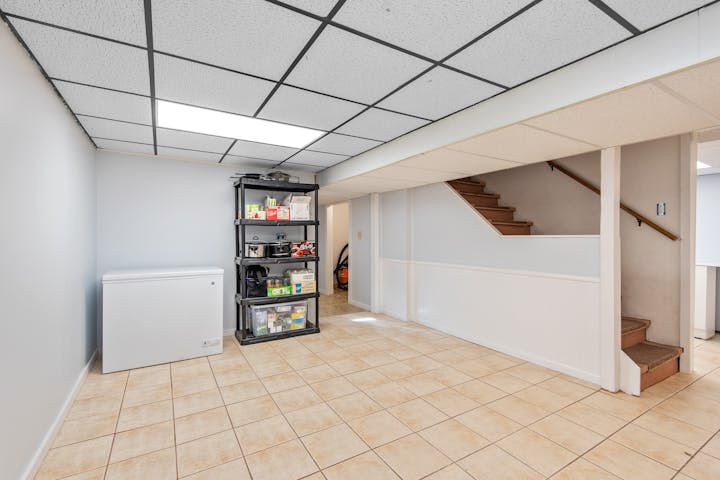When you first moved in, your home may have felt just right—plenty of space, the perfect location, and everything in place. But lately, does it feel like you’re constantly running out of room? Whether it’s a growing family, a shift to remote work, or new hobbies taking over the living room, it’s not unusual for your lifestyle to outgrow your space.
You might be tempted to pack up and look for a larger home, but in a city like Naperville, where the cost of living is higher than both the national and Illinois averages, that can be a costly decision. But, here’s something you’ll be glad to know: You don’t necessarily need a bigger house to get more space. With some creative planning and smart improvements, you can unlock hidden potential in your current home.
This article will walk you through eight practical, effective ways to make room, without the stress of moving.
1. Transform Your Basement into Usable Living Space
Basements shouldn’t just be for dumping old furniture. They can hold huge potential when it comes to creating more livable space. A finished basement can serve as a family lounge, a guest suite, a playroom, or even a home office. However, basements also come with unique challenges, especially in Naperville, where winter temperatures regularly fall below freezing.
Before jumping into a basement remodel, it’s important to address insulation, moisture control, and proper ventilation. Cold floors, dampness, or poor air circulation can make the space uncomfortable and even unsafe.
Working with a top Naperville basement remodeling company ensures that these issues are addressed properly. They understand how to make the basement warm, dry, and energy-efficient—key factors in turning it into a comfortable extension of your home.
2. Install Built-In Storage to Reduce Clutter
One of the easiest ways to gain space without adding square footage is to cut down on clutter. Built-in storage solutions let you do just that while also making your home more visually appealing. Instead of standalone cabinets or shelves that take up room, built-ins fit neatly into the structure of your home.
You can add shelving in unused corners, install under-the-stair storage drawers, or add seating with hidden compartments. These options help keep your belongings organized and out of sight, making every room feel more open and less chaotic.
3. Use Multi-Functional Furniture
When space is limited, everything in your home should work a little harder. That’s where multi-functional furniture comes in. These are pieces designed to serve more than one purpose, such as beds with built-in drawers, sofas that can be used as guest beds, or dining tables that expand when needed.
This kind of furniture lets you get more use out of each item, freeing up space for other things. It’s especially helpful in smaller homes or apartments where you need to be selective about what you bring in. Look for pieces that offer storage, convertibility, or hidden compartments to help streamline your living areas.
4. Create Zones in Open Areas
Open floor plans are popular for good reason—they make homes feel airy and connected. But without defined zones, open spaces can easily become cluttered or confusing. By creating zones within a single room, you give each part of the space a clear purpose.
This doesn’t require building walls. You can use rugs to define an area, lighting to highlight specific spaces, or furniture placement to carve out sections. For instance, a reading nook with a lamp and armchair in one corner, and a small desk setup in another, can help one room serve multiple roles without crowding it. When planning your open floor layout, consider how accessibility features like a home elevator might enhance the flow between levels. Companies like Cube Lifts specialize in compact elevator solutions that integrate seamlessly into open-concept designs, ensuring your multi-level home maintains its spacious feel while providing convenient access to all areas.
5. Maximize Closet Space with Custom Organizers
Most closets aren’t used to their full potential. With a few changes, they can hold much more than you might think. Adding custom organizers like double hanging rods, shelf dividers, drawers, or over-the-door racks can double or even triple the storage space in a closet.
Instead of piling things on top of each other or letting seasonal items take over your bedroom, a well-organized closet can keep everything in its place.
6. Convert the Attic into a Bonus Room
If you’re lucky enough to have an attic with decent height and solid flooring, you’re sitting on prime potential living space. Instead of using it only for storing old boxes and holiday decorations, consider transforming it into a bonus room. Whether it becomes a guest bedroom, home office, art studio, or a quiet retreat for reading and relaxation, the attic can serve many purposes.
Before converting, ensure the space is structurally sound and properly insulated. Attics are often susceptible to temperature extremes, so it’s important to regulate heat and cooling for year-round use. Adequate lighting and ventilation are also key. A few skylights can make a huge difference in making the space feel open and welcoming.
Once these basics are in place, you can customize the room based on your lifestyle needs.
7. Reclaim Your Garage
Garages often become dumping grounds for items that don’t have a proper place inside the house. Tools, sports gear, seasonal decorations, and long-forgotten furniture can pile up quickly. But if you don’t mind parking outside, it might be time to rethink its function.
A well-organized garage can still hold essentials while doubling as a functional room. Add overhead storage racks, wall-mounted shelves, or pegboards to keep things tidy. Then, depending on your interests, you could convert part of the space into a gym, workshop, or even a small lounge area.
8. Install Pocket or Sliding Doors
Yes, the right doors can also create more space. Traditional swinging doors take up room as they open and close, which can limit furniture placement or flow in smaller areas. Replacing them with pocket or sliding doors can open up square footage in tight spots like hallways, bathrooms, or compact bedrooms.
Pocket doors slide neatly into the wall, disappearing completely when open. Sliding barn-style doors are another stylish and functional option, especially if you want something more decorative.
Both choices allow for better movement through your home and provide the flexibility to rearrange or make better use of the available space.
Sometimes, making room is less about adding more and more about seeing your home in a new way. Whether you’re converting your basement, maximizing your garage, or simply swapping a door, small changes can create a big difference in how your home functions. With a little creativity and some thoughtful upgrades, you can continue to live comfortably and efficiently in the space you already call home. Every square foot has the potential to serve you better—you just have to make it work a little harder.





